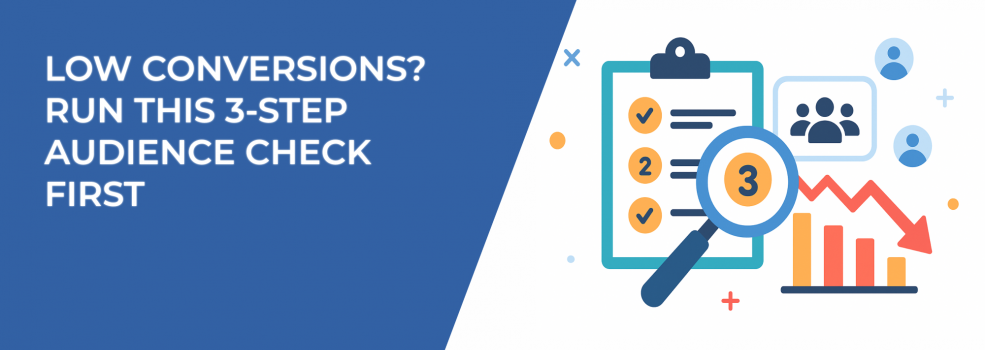When conversions dip, most marketers reach straight for creative fixes. They swap images, rewrite copy, or adjust landing pages. Those changes might help, but they’re often surface-level tweaks that don’t solve the real issue. In many cases, poor results come down to one thing: the audience.
You can’t convince the wrong people to buy no matter how sharp the ad looks. That’s why running an audience check is the first step before pouring more money into optimization. Below is a structured 3-step process designed to help you evaluate whether your targeting is strong enough to support conversions.
Step 1: Revisit Audience Relevance
Relevance is the backbone of advertising. Even a perfectly written ad fails if it’s aimed at people who don’t have a reason — or authority — to act on it. Advertisers sometimes overestimate how well their targeting aligns with their buyers, and that misstep becomes costly at scale.
Think about a company advertising a high-ticket software tool. If their ads are being shown to general “tech enthusiasts” instead of decision-makers within companies, engagement may look good at first, but leads won’t materialize. In this case, the audience is interested but not in a position to buy.
What to check:
-
Match targeting to buyer personas. Compare your defined personas with actual campaign targeting. Do your demographics, job titles, or interest categories reflect real decision-makers?
-
Measure click-to-conversion ratios. A strong CTR but poor sign-up rate suggests misaligned intent. The audience cares about the topic but isn’t ready to take the action you want.
-
Test layers of intent. Go beyond broad interests. Combine behaviors (e.g., recent website visitors, engaged video watchers) with demographic filters to build sharper relevance.
If you need practical frameworks for improving precision, explore methods like layered targeting for hyper-specific audiences. A more focused approach will save budget and improve lead quality.
Step 2: Analyze Audience Saturation
Relevance isn’t enough if your audience is exhausted. Overexposure creates fatigue, and fatigue kills performance. Even if people were once excited about your ad, repeated impressions dull that response.
The signs of saturation are subtle but measurable. You’ll often see CTR declining while impressions remain consistent. Conversion costs creep upward as the algorithm struggles to find fresh eyes within the same pool. Some users even start hiding or reporting ads — an expensive signal that you’ve overstayed your welcome.
Key signals to track:
-
High frequency without return. If your frequency is above 4–5 per person and conversions haven’t improved, fatigue is likely setting in.
-
Downward CTR trends. Declining engagement in the face of steady delivery often signals boredom rather than irrelevance.
-
Negative feedback rising. Watch for “hide ad” or “report” clicks. These harm ad quality scores and push up costs.
The fix doesn’t always mean abandoning the audience. Sometimes, rotating creative formats or refreshing ad visuals can revive interest. In other cases, building lookalike audiences or layering in broader interest categories helps reset delivery while keeping intent strong. If this feels familiar, you may want to read more about how to spot ad fatigue early and fix it fast.
Step 3: Check Audience Size and Structure
An audience that’s too broad wastes money on people who will never convert. An audience that’s too narrow chokes delivery, leaving algorithms with too little data to optimize. Striking the right balance takes more than guesswork.
One mistake many advertisers make is slicing audiences so thin that each ad set competes with the others. Splintering “small-business owners,” “marketing managers,” and “agency directors” into separate buckets can spread budgets too thin. On the flip side, dumping them all into one large group risks mixing intent signals and confusing the algorithm.
What to consider:
-
Audience size thresholds. Under 10k people is often too restrictive, while over 10 million loses targeting power. Aim for a balance where delivery is steady but signals are strong.
-
Ad set structure. Consolidating similar audiences into fewer ad sets can improve performance by giving algorithms more data to optimize against.
-
Regional and language splits. Sometimes relevance is less about numbers and more about context. Running English ads to non-English audiences within the same set, for example, dilutes results.
For a more structured perspective on audience segmentation, see interest stacking as a powerful method. Done right, structuring your sets creates stability and prevents wasted spend.
Critical Takeaway
Low conversions don’t always mean your offer is bad or your creatives are weak. More often, it’s about how and where your ads are delivered. By systematically reviewing audience relevance, saturation, and size, you’re able to identify the root cause of underperformance.
Ask yourself: Am I chasing clicks, or am I building pathways for real conversions? This distinction separates campaigns that drain budgets from those that scale profitably.
If you’re serious about improving conversions, make the audience check part of your routine review process. And if you’d like to take this further, check out guides like everything you need to know about Facebook audiences or smart audience building for Facebook to deepen your strategy.

